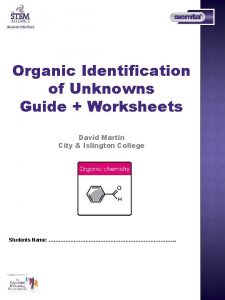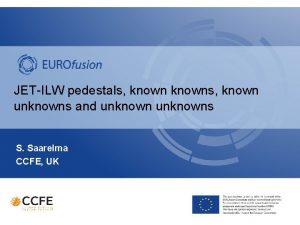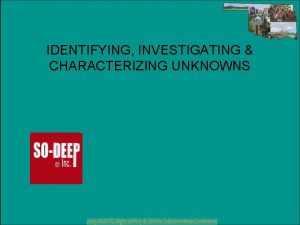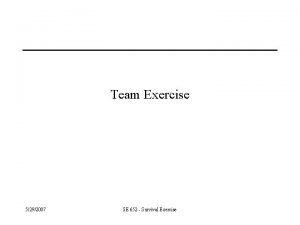Lunar Survival Organic Identification of Exercise Unknowns Guide









- Slides: 9

Lunar Survival Organic Identification of. Exercise Unknowns Guide +Michelle Fearn Worksheets North Herts College David Martin City & Islington College Students Name: …………………………………. .

Topic Organic Identification of Unknowns Aims Ø A workbook that contains organic practical tests to identify unknown Ø A selection of possible unknowns and a sheet for students to fill in to show their reasoning Ø This is an excellent resource for the VTEC Unit 22 – Chemical Laboratory Techniques Level 3 Method A workbook that contains practical tests (for students), to identify unknown. Also attached to this workbook is a sheet for students to fill in showing their reasons, and a selection of possible unknowns. Equipment Ø Ø Hand-Outs Slideshow/Laptop/Projector Printer Pens/Pencils/Note Pads Duration > 30 Minutes

Organic Identification of Unknowns A collection of practical organic tests for identifying functional groups in organic chemistry Testing for Hydrocarbons Experiment 1 – Combustion Procedure Carefully place a few drops of the hydrocarbon on a watch glass in a fume cupboard. Carefully light the hydrocarbon with a splint and observe the following: - the colour of the flame - the soot content of the flame - the colour of the watch glass at the end of the burning Experiment 2 – the addition of bromine water Procedure 1) Put about 1 cm 3 of your hydrocarbon into a test tube. 2) Add 5 drops of bromine water to the test tube. 3) Put a bung on the tube and shake Care – Bromine and bromine water are very corrosive and toxic. Perform this experiment in a fume cupboard. Possible Results Hydrocarbon Alkane Alkene Arene Burning Clean yellow flame, very little soot Yellow flame, some soot Orange flame, lots of soot Bromine water Stays orange Orange - colourless Stays orange

Organic Identification of Unknowns Testing for Carbonyl Compounds The test for the carbonyl group – both aldehydes and ketones will give a positive test in this reaction. Procedure 1) Add 5 cm 3 of 2, 4 dinitrophenylhydrazine (2, 4 DNP) to a test tube. 2) Add 5 drops of your unknown to the tube 3) Cork the test tube and shake the mixture. If a solid does not form within a few minutes add 1 cm 3 of dilute sulphuric acid drop-wise and shake. Oxidation reactions – methods to distinguish aldehydes from ketones Silver mirror test 1) Use a really clean test tube. 2) To a test tube add 2 cm 3 of silver nitrate and 1 drop of dilute sodium hydroxide solution. You should get a brown solid. Add dilute ammonia solution drop wise and shake until all the brown solid dissolves. 3) Add 3 drops of your unknown to the solution of silver nitrate in ammonia. Then place the tubes in a beaker of near boiling water for 5 minutes. If a silver mirror forms your unknown compound is an aldehyde. Fehling’s test 1) Add 1 cm 3 of solution 1 (the blue solution) to a test tube and the add 1 cm 3 of solution 2 the (colourless solution) into solution 1 and shake till you get a deep blue solution. 2) Add 3 drops of your unknown to the deep blue solution and then place the test tube in a beaker of boiling water for 5 minutes. If a red solid forms your unknown compound is an aldehyde.

Organic Identification of Unknowns Testing for Carboxylic Acid Test the p. H of a solution of a carboxylic acid A carboxylic acid solution should: i) Turn blue litmus paper red. ii) Or turn universal indicator paper red. Add sodium carbonate solid to a solution of the carboxylic acid On the addition of solid sodium carbonate to a solution of a carboxylic acid fizzing should be observed as carbon dioxide gas is generated. This gas could be tested with a drop of lime water – the lime water should go milky Test for an amine Test the p. H of a solution of an amine An amine solution should: i) Turn red litmus paper blue. ii) Or turn universal indicator paper blue.

Testing Organic Unknowns Flowchart

Organic Identification Of Unknowns Name ______________Date _______ Letter ________ Test Add about 5 cm 3 of distilled water to a test tube. Add about 1 cm 3 of your unknown. Put a bung on the tube and shake. Result Inference The identity of the unknown compound is _______________

Organic Identification Of Unknowns Identification unknown organic chemicals Practice Practical A = Methanol B = Propan 2 ol C = 2 Methyl propan 2 ol D = Carboxylic acid E = Acetone F = Aldeyhde G = Amine H = Methyl Benzene I = Hexane J = Hex 1 –ene Identification unknown organic chemicals Assessed Practical A Ethanol B Hexane C Ethanoic Acid D Ethanal E Propanone F Phenylamine (aniline) G 2 -methyl propan-2 -ol H Hex-1 -ene I Methyl benzene J Propan-2 -ol

For further information please contact The STEM Alliance enquiries@STEMalliance. uk or visit www. STEMalliance. uk
 Lunar survival activity
Lunar survival activity Equation with two unknowns
Equation with two unknowns Known unknowns matrix
Known unknowns matrix Dot product ti 89
Dot product ti 89 State of survival survival of the fittest tweak
State of survival survival of the fittest tweak State of survival survival of the fittest stages
State of survival survival of the fittest stages Desert survival team building exercise ppt
Desert survival team building exercise ppt Ihca chain of survival exercise
Ihca chain of survival exercise Central pocket whorl vs plain whorl
Central pocket whorl vs plain whorl Software project survival guide
Software project survival guide

















